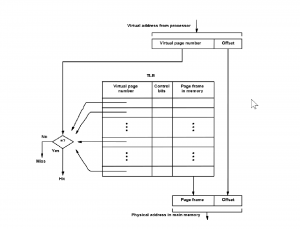What is TLB (TRANSLATION LOOK ASIDE BUFFER )
Companies Related Questions, Computer Archtecture 0 CommentsThis portion consists of the page table entries that correspond to the most recently accessed pages. A small cache, usually called the Translation Lookaside Buffer (TLB) is incorporated into the MMU for this purpose. The operation of the TLB with respect to the page table in the main memory is essentially the same as the operation of cache memory; the TLB must also include the virtual address of the entry.
An essential requirement is that the contents of the TLB be coherent with the contents of page tables in the memory. When the operating system changes the contents of page tables, it must simultaneously invalidate the corresponding entries in the TLB. One of the control bits in the TLB is provided for this purpose. When an entry is invalidated, the TLB will acquire the new information as part of the MMU’s normal response to access misses. Address translation proceeds as follows. Given a virtual address, the MMU looks in the TLB for the referenced page. IT the page table entry for this page is found in the TLB, the physical address is obtained immediately. If there is a miss in the TLB, then the required entry is obtained from the page table in the main memory and the TLB is updated.
When a program generates an access request to a page that is not in the main memory, a page fault is said to have occurred. The whole page must be brought from the disk into the memory before access can proceed. When it detects a page fault, the MMU asks the operating system to intervene by raising an exception (interrupt). Processing of the active task is interrupted, and control is transferred to the operating system. The operating system then copies the requested page from the disk into the main memory and returns control to the interrupted task. Because a long delay occurs while the page transfer takes place, the operating system may suspend execution of the task that caused the page fault and begin execution of another task whose pages are in the main memory. It is essential to ensure that the interrupted task can continue correctly when it resumes execution. A page fault occurs when some instruction accesses a memory operand that is not in the main memory, resulting in an interruption before the execution of this instruction is completed. Hence, when the task resumes, either the execution of the interrupted instruction must continue from the point of interruption, or the instruction must be restarted. The design of a particular processor dictates which of these options should be used

If a new page is brought from the disk when the main memory is full, it must replace one of the resident pages. The problem of choosing which page to remove is just as critical here as it is in a cache, and the idea that programs spend most of their time in a few localized areas also applies. Because main memories are considerably larger than cache memories, it should be possible to keep relatively larger portions of a program in the main memory. This will reduce the frequency of transfers to and from the disk. Concepts similar to the FIFO, Optimal and LRU replacement algorithms can be applied to page replacement and the control bits in the page table entries can indicate usage. One simple scheme is based on a control bit that is set to 1 whenever the corresponding page is referenced (accessed). The operating system occasionally clears this bit in all page table entries, thus providing a simple way of determining which pages have not been used recently.
A modified page has to be written back to the disk before it is removed from the main memory. It is important to note that the write-through protocol, which is useful in the framework of cache memories, is not suitable for virtual memory. The access time of the disk is so long that it does not make sense to access it frequently to write small amounts of data. The address translation process in the MMU requires some time to perform, mostly dependent on the time needed to look up entries in the TLB. Because of locality of reference, it is likely that many successive translations involve addresses on the same page. This is particularly evident in fetching instructions. Thus, we can reduce the average translation time by including one or more special registers that retain the virtual page number and the physical page frame of the most recently performed translations. The information in these registers can be accessed more quickly than the TLB.